Paris 2024 Olympics: for the first time, Casa Italia opens to the public with an exhibition and scenic route
From Saturday, July 27, Casa Italia Paris 2024 at Le Pré Catelan - the place chosen by CONI to welcome the athletes of the Italy Team and its guests during the XXXIII Olympic Games in Paris, scheduled until August 11, 2024. For the first time in the history of Casa Italia, the public will be able to access and immerse themselves in an exhibition, scenic and emotional journey: a total work of art, architecture and design entitled Ensemble. This emblematic building, a Napoleon III-style construction nestled in the Bois de Boulogne, the city’s largest park and just a stone’s throw from the Champs-Élysées, is loaded with history. On the evening of June 23, 1894, the dinner desired by Baron Pierre de Coubertin to celebrate the birth of the Olympic Games of the modern era was held there.
For Paris 2024, Casa Italia creates a symbolic and concrete link with the “Father” of the modern Olympics and with France, the closest “brother” country since the days of the Roman Empire. Through its revolt, France has initiated a process of awareness of being a community and democratic principles. Of the motto Liberté, Egalité, Fraternité that characterizes the French Revolution, Casa Italia Paris 2024 focuses on Brotherhood, the term most in tune with the founding values of the Olympic spirit and the most necessary in this era torn by new conflicts and pandemic threats, to imagine a new utopia and a new peace.
Developing, therefore, the Ensemble concept, Casa Italia Paris 2024 has transformed Le Pré Catelan into an extraordinary space where nature, art, architecture, furniture design and light design are harmoniously integrated. The building, featuring numerous windows and surrounded by a garden, has been renovated with plants typical of the Italian landscape. The interiors recall the Italian tradition and the masters of the 20th century, famous for their creativity and hospitality.
The exhibition includes works by 19 contemporary Italian artists, including Vincenzo Agnetti, Marco Bernardi, and Marinella Senatore, and creations by 32 international designers for 11 companies of excellence in Italian design, such as Edra, Ethimo, Glas Italia, and Moroso. The designers include prominent names such as Mario Bellini, Patricia Urquiola, and Ron Arad.
The architectural design of Casa Italia is based on the link between new and existing, artifice and nature. The idea of “Ensemble” is inspired by the interweaving of the Olympic Circles, as interpreted by sociologist Tim Ingold: a fabric of lines knotted together, where the knots represent the center of things. This concept is reflected in the layout of Casa Italia, with rooms created within the 19th-century architecture of Pré Catelan using a semi-transparent fabric that enhances both the interior and exterior spaces. The furnishings, a selection of iconic elements of Italian design, both historical and contemporary, establish an aesthetic dialogue with the context and setting. The choices of shapes, colors and materials create a cohesive and evocative environment, reflecting the excellence of Italian design and the hospitality for which it is renowned.
Great attention was paid to environmental sustainability in Casa Italia Paris 2024. The predominant use of natural and recycled fabrics reduces the weight of transporting fit-out materials, lowering CO2 emissions and making the project sustainable with a low impact on the ecosystem. The furniture also reflects this commitment, with Italian design objects conceived to last and be handed down, made with virtuous processes that consider the entire product life cycle.
Many design elements chosen or designed for Casa Italia express ecological sensitivity through a strong aesthetic and material component, including furniture made of wood, terracotta, enameled lava, raw fabrics, cellulose and recycled plastic. The Casa Italia press room is zero-impact thanks to a protocol signed with the Ministry of the Environment and Energy Security, and the support of Federlegno and its member companies.
Sustainability is another aspect of the Ensemble concept, as addressing climate change and environmental disasters requires collective collaboration. This commitment reflects the need to act together for a sustainable future, demonstrating that art, design and sustainability can coexist and create a positive impact on the environment and society.
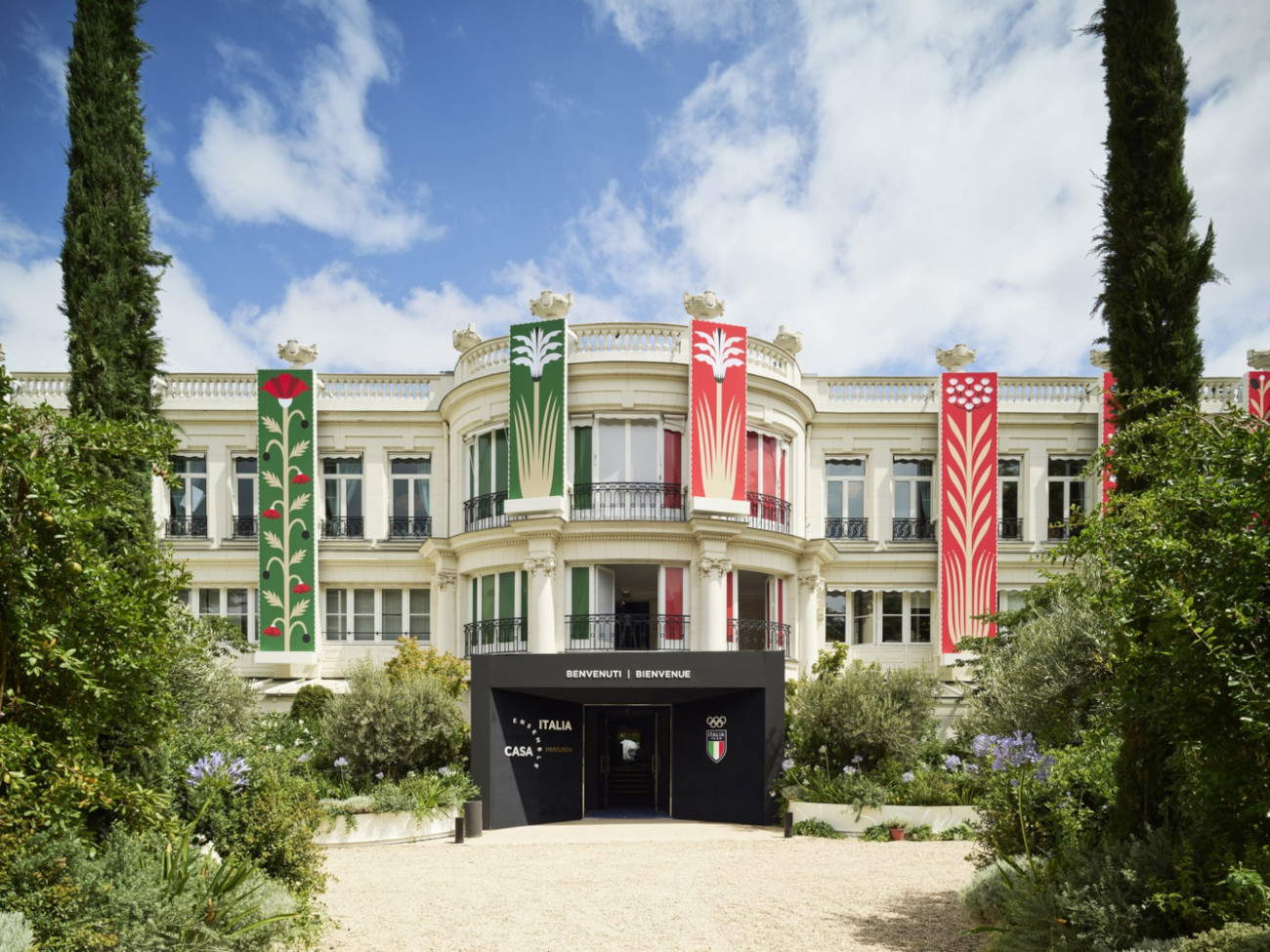
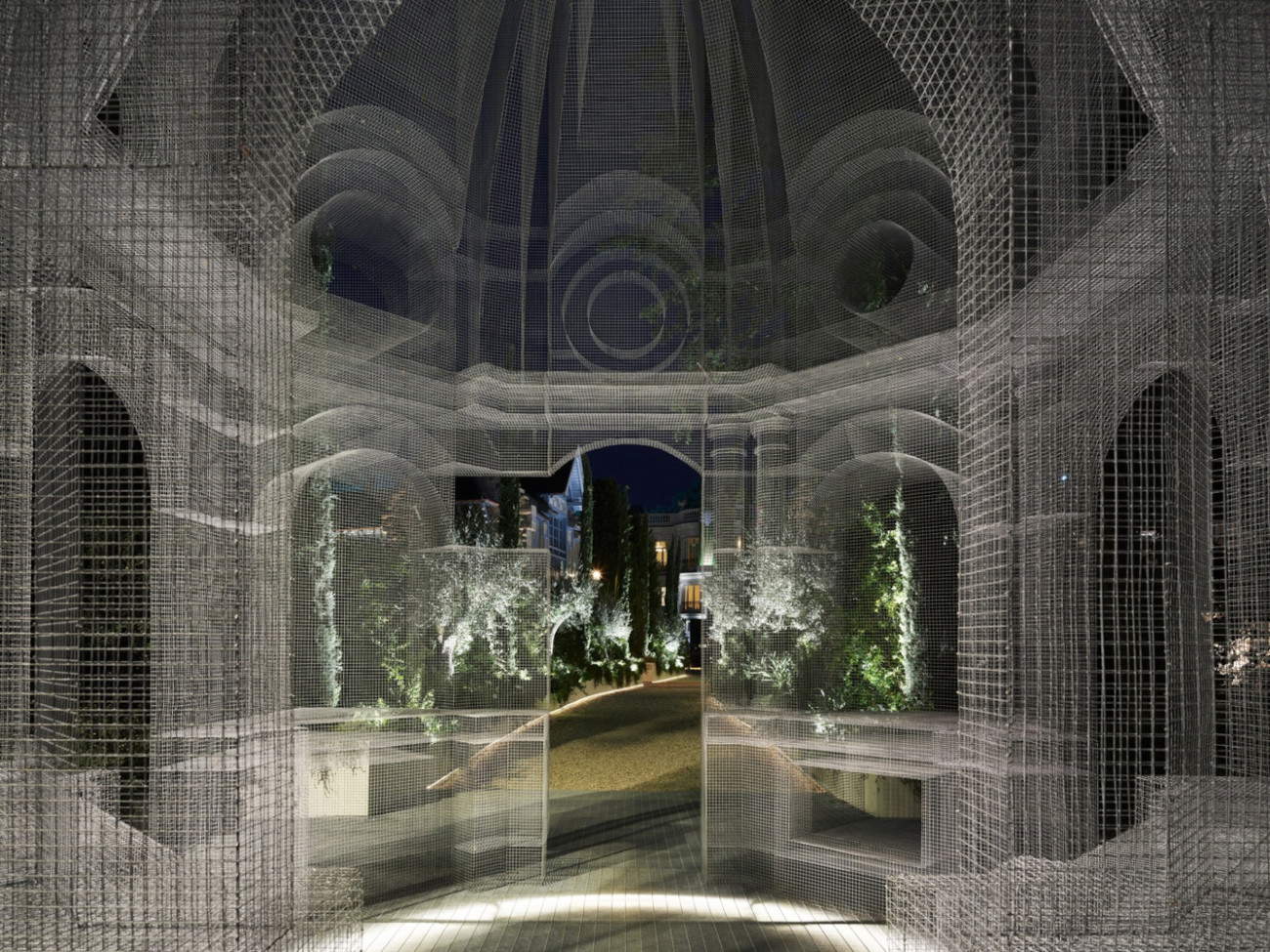
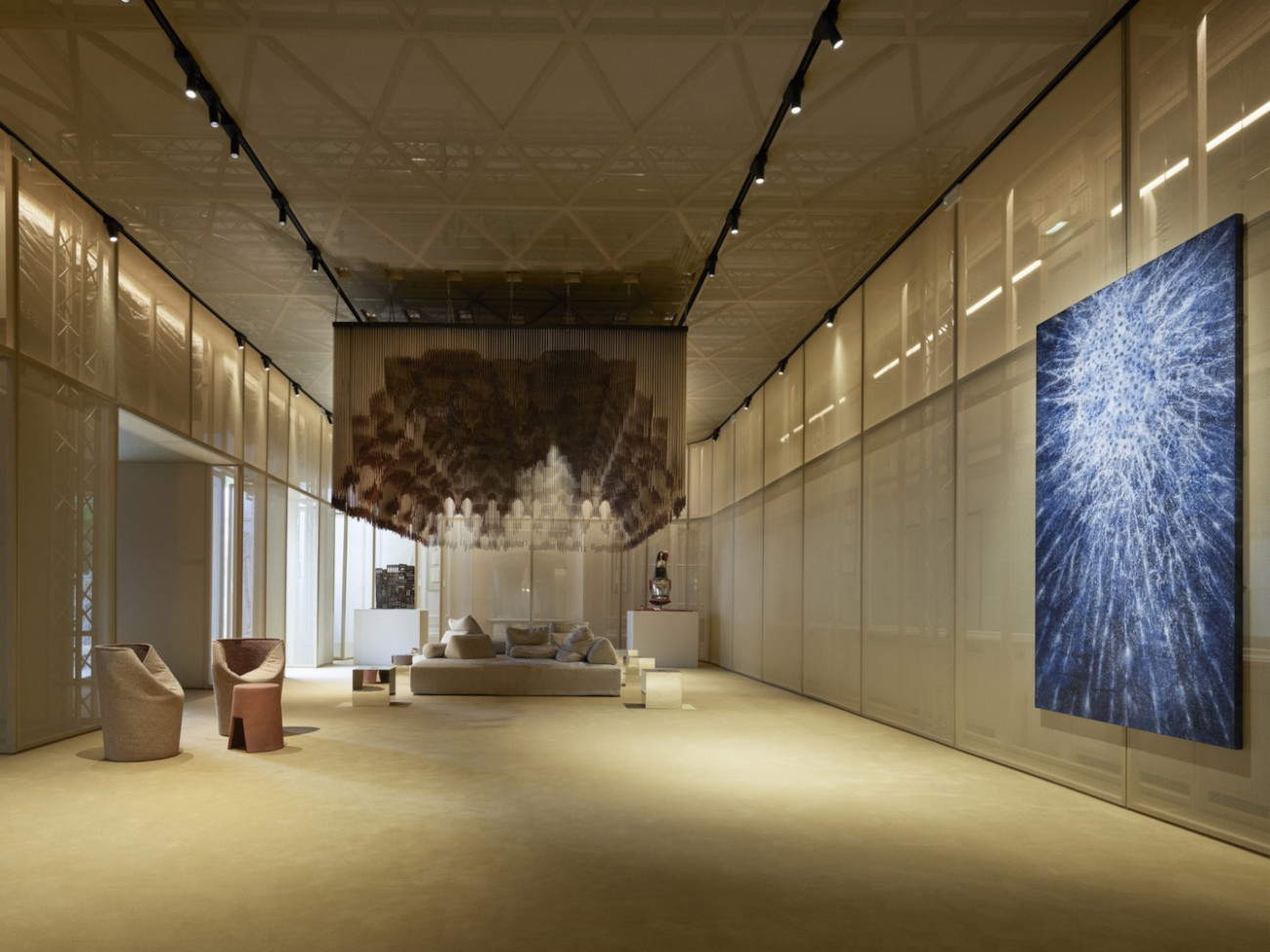
The exhibition route
The exhibition route of Casa Italia Paris 2024, curated by Beatrice Bertini and Benedetta Acciari, begins outside with a copy of the inscription “Italia” from the entrance of the historic Italian Pavilion at the Venice Biennale, paying homage to one of the most important artistic events in the world. Behind this inscription is the Acciari Pavilion, a corten-colored mirrored volume, harmoniously set in the context of the surrounding forest. Made with Pratic’s bioclimatic modules, this pavilion is set up as a living room in warm, natural tones, with a Standard sofa by Francesco Binfaré and Cicladi coffee tables by Jacopo Foggini in natural alabaster, both designed for Edra. A sinuous wooden counter and Capitain Flint floor lamps by Micheal Anastassiades (Flos) in warm earth tones welcome visitors, emphasizing that Casa Italia is first and foremost a place of hospitality.
Continuing along the exhibition route, visitors are greeted by the work “Sacral” by sculptor Edoardo Tresoldi, inspired by the forms of the Renaissance baptistery. This work serves as a symbolic and physical gateway, transporting visitors into the dimension of Ensemble through a weave of metal mesh. A monumental tree-lined avenue, by the studio Natura e Architettura and enhanced by lighting by Massimo Pascucci, leads to the space in front of Le Pré Catelan, reconfigured as a symbolic Italian Piazza, a space for meeting and welcoming.
This square is overlooked by the pavilions dedicated to the Media Factory and the bistro, with metal and teak furniture designed by Patrick Norguet for Ethimo’s Swing collection and the Hut alcove designed by Marco Lavit for the same brand. Natural wood, the dominant material in this area, contributes to a relaxed and informal atmosphere. The facade of the main building hosts a large site-specific work by Agostino Iacurci entitled “Ensemble,” a reinterpretation of the Tricolor in its typical floral and abstract style, blending natural imagery with a reinterpretation of classical aesthetics.
Inside the main building, the system of “rooms within rooms” shows a layout curated by architecture firm IT’S, featuring a mutually enhancing structure. Here the Olympic medal box, which will grow during the competition, stands out, encompassed and embellished by the work “Panorama Italia,” a 30-square-meter tapestry by Giovanni Bonotto. This tapestry covers all the walls, creating an immersive environment that enhances the Ensemble through the cultural, historical, geological, landscape, gastronomic and linguistic variety of Italy. The tapestry design was created with the help of Artificial Intelligence, using yarns obtained from recycling plastic waste.
The entrance to the heart of the House is marked by Marinella Senatore’s luminous work, “We Rise by Lifting Others,” which echoes a famous quote by Robert Ingersoll, “We rise by lifting others.” This work speaks of the power of helping others and the positive impact this can have on ourselves, emphasizing the values of solidarity and brotherhood.
The Gallery’s spacious entrance is designed as an abstract and elegant environment, covered with a semi-transparent fabric by Rubelli, whose yellow color illuminates the space, enhancing its physical and symbolic value. The visitor is greeted by a series of works, the first of which is by Vincenzo Agnetti, an absolute protagonist of the second half of the 20th century. With the iconic work “Tra me e te l’infinito inesistente,” a rigorous structure in which the vague and elusive meaning can be perceived only through the complicity of the observer’s gaze. Also in the Gallery, the work by Julie Polidoro, a French-born and Roman-by-adoption artist, entitled “All the Great Equal Countries,” celebrates the Olympic spirit by eliminating hierarchies between the nations of the world based on territorial dimensions in a geographical map in which the various nations become a multitude of shapes and colors. Another artistic connection between Italy and France can be found in Fabio Viale’s sculpture “Amore e Psiche,” a contemporary reinterpretation of Canova’s “Cupid and Psyche” housed in the Louvre, in which Venus is rendered black by an integral tattoo in a clear homage to diversity. The link between the two countries and between sustainability and the concept of “Ensemble” is then found in the painting “We Are All Collaborating” by the French-Italian collective Claire Fontaine, which draws attention to social, humanitarian and environmental emergencies, where the concept of being together is understood as the need to collaborate on global issues. The overall concept of Casa Italia Paris 2024 is clearly manifested in the large sculptural work by Margherita Moscardini, who in “(Ou la mort)” extrapolates the most overlooked word of the famous French motto, making it the most important and capable of also summarizing the concepts of freedom and equality, repeating “Fraternité, Fraternité, Fraternité,” providing a new paradigm of being together despite being different.
In the center of the Gallery space, a blue line made up of the modules of the iconic Camaleonda sofa, designed by Mario Bellini and made by B&B Italia, accompanied by the Up armchair by Gaetano Pesce, another great name in design who recently passed away, dialogues with the artworks and the large volume of the room. In the spaces of the Gallery, the idea of relationship and connection is developed on the double plane of the infinitely small and the infinitely large in Alberto Di Fabio’s work, “Astral Life,” which introduces us to the mysterious and fascinating phenomena of nature, exploring the cellular world and the constellations, in a vision in which everything is connection and synthesis of the universe. Among the most impressive works exhibited at Casa Italia, there is definitely the “Flying Carpet” created by the Stalker collective, together with the exiled Kurdish community in Rome, a group of activist architects, a Roma boy and one from Senegal, in which 41472 hemp ropes with copper terminals reproduce the muqarnas of the ceiling of the Palatine Chapel in Palermo, a symbol of a millenary culture of welcome that unites Greek, Latin, Arab and Norman cultures. Underneath this extraordinary spatial work are two Sherazade sofas designed by Francesco Binfaré for Edra, which, with their system of freely configured movable cushions, allow people to sit or lie down to look up at the work, contributing to the experience of enjoying the work itself. Continuing through the spaces of the Gallery, we find the colored bronze sculpture “Italiana” by Paolo delle Monache, which expressly celebrates Italy and its wonders, exalting the uniqueness of our territory resulting from the variety of elements that make it unforgettable.
The artistic itinerary includes an exclusive novelty that Casa Italia is privileged to host: the special equipment and accessories of the Corazzieri Regiment, an elite unit of the Carabinieri Corps under the auspices of the Presidency of the Republic. The magnificence of the uniform on display includes a breastplate, typical of heavy cavalry for which soldiers were called cuirassiers, a helmet and a saber.
At the center of Casa Italia, in the Gallery and surrounded by the works of art, emerges the Celebration Room, a cylinder that serves as the epicenter of Le Pré Catelan’s celebration of sport, Italy and its medals. This space, curated by InformaSistemi, is wrapped in screens and designed as a contemporary amphitheater where the athletes’ celebration punctuates the day. At other times, it becomes a place to represent Italian excellence in all its aspects: a visual explosion of digital artworks, images of the Bel Paese and multimedia content that flow in sequence, conveying the high value of Italy.
Not far away, we find the lounge with Paolo delle Monache’s second work entitled “Serendipity,” a column representing numerous Italian monuments that envelops, protects, supports and constitutes an individual. This area is characterized by a long perimeter window that separates the interior from the garden, conceived as a space extended outward, where interior and exterior merge and the vegetation of the Bois de Boulogne becomes the protagonist. The interior design, by Atelier Bianca E. Patroni Griffi, aims to eliminate the boundary between inside and outside, recreating a fluid landscape permeated by natural elements with earthy, natural colors.
The landscape is delineated at the entrance of the lounge by a circular bar counter on one side and two ring benches on the other, conceived as atolls, islands with internal vegetation. These three elements were custom-made with an innovative material based on paper microfibers from recycled paper and FSC-certified forests, a sort of evolution of paper mache, developed in collaboration with the University of Salento in Lecce by Paper Factor, an Italian company located in Puglia.
In the center of the lounge, two Standard sofas by Edra are arranged vis-à-vis, reinforcing the central axis that defines the symmetry of the space. Two compositions of Ribes sofas designed by Antonio Citterio, in shades of red, with Borea low tables by Piero Lissoni in red enameled lava, both for B&B Italia, accompany the linear development of the glass window toward the garden, creating two mirrored lounge areas, flanked by solid wood benches by Brodie Neill for Riva 1920.
Continuing with the intention of enhancing the fusion of interior and exterior, a new axis of symmetry is established along the glazing. As in a game of mirrors, Ribes sofas are found in the garden, this time colored green, paired with Borea tables (Piero Lissoni) in green enameled lava. The islands of outdoor sofas are joined in the garden by Crinoline armchairs designed by Patricia Urquiola for B&B Italia. A series of multicolored seating punctuates the garden like flowers, creating a connection between the new outdoor areas and the surrounding landscape, combining the Mediterranean essences of Casa Italia with the local vegetation of the park. Seating includes armchairs from the Shadowy and Sunny collections, designed by Tord Boontje, and Modou by Ron Arad for Moroso, featuring graphic designs and playful, colorful materials. Also in the outdoor garden space is a second circular bar counter, custom-made from Plastiz, a material derived from plastic waste and completely recyclable, produced using only energy from renewable sources.
Returning inside from the Gallery, you enter the Milano-Cortina room, an immersive experience dedicated to snow and ice. Seats designed by Jacopo Foggini, which reproduce on the backrest the shape of Milan Cathedral, along with sofas by Francesco Binfaré, both for Edra, furnish the space around the mirrored volume that houses the installation. Outside, outdoor seating by Jacopo Foggini for Edra, with transparent weaves, evokes water and ice.
Ascending to the upper floor of Le Pré Catelan is a monumental staircase illuminated by the sculptural composition Arrangements by Michael Anastassiades for Flos, with a symbolic concatenation of luminous circles. Visitors are greeted by Fun with Flags, a series of works by Riccardo Previdi in which the artist mixes different flags of the world, creating colorful and novel patterns. The exhibition tour continues with Patrick Tuttofuoco’s diptych Time Capsule, which explores the theme of intertwining through intertwining hands, becoming a universal symbol of brotherhood.
The first room on the upper floor is the Casa Italia Room, located on the mezzanine level. This oval space allows a view of the avenue and Edoardo Tresoldi’s Sacral work from inside the Casa. Furnishings include ample seating from Francesco Binfaré’s Standard series and Jacopo Foggini’s Cicladi tables in alabaster in colors green, white and red, in homage to the Italian flag (both made by Edra). Lighting is provided by Bellhop floor and wall sconces by Edward Barber and Jay Osgerby for Flos.
The continuous cross-reference between interior and exterior also characterizes the second floor of Le Pré Catelan, where green is the predominant color, enhanced by the lush vegetation visible through the large windows. The space is divided into a series of rooms, mainly intended for Casa Italia’s Hospitality rooms. Each room, while maintaining a common thread, has its own identity defined by the choice of furnishings and artwork. To the right of the access staircase, the Hospitality room for athletes is decorated with iridescent Shimmer tables designed by Patricia Urquiola for Glas Italia and Gilda chairs by Jacopo Foggini for Edra. A large On The Rocks sofa by Francesco Binfaré for Edra defines the boundary between the indoor hall and the outdoor terrace. Here, sinuous bas-reliefs by artist Sergio Breviario, titled Bianca and Marion, enhance the complexity of each individual, inviting curiosity and welcome.
Next to this is a more intimate room, where the green/blue Ella seating designed by Jacopo Foggini for Edra is paired with transparent glass Hub tables by Piero Lissoni for Glas Italia. The room overlooks a small semicircular terrace with two outdoor version modules from Francesco Binfaré’s Standard series. Gabriele Picco’s two canvases, Lasciarsi attraversare dall’arcobaleno and Nuotando nel cielo, express the joy of breaking isolation, depicting human figures immersed in a rainbow or in a context reminiscent of a collective “condominium.” The spaces are illuminated by Viscontea and Zeppelin light suspensions, respectively designed by Achille and Pier Giacomo Castiglioni in the 1960s and Marcel Wanders in the early 2000s, reinterpreting classic chandelier designs.
Hospitality rooms include Gina and Gilda chairs, with translucent shells by Jacopo Foggini for Edra, accompanied by Jabot tables by Mario Bellini for Glas Italia or custom-made white plastic tables with transparent inserts, made by Plastiz from recycled materials. Lighting is provided by Achille Castiglioni’s iconic Teraxacum 88 suspension lamps and Michael Anastassiades’ String Lights, both for Flos. Continuing in the exhibition, Francesco Jodice explores mutual support and collaboration in the photographic diptych The Surfers, in which surfers wait for the wave in an almost metaphysical sea, symbolizing a collective confrontation with the unknown. Among the works, Marco Bernardi’s Messa a Terra, inspired by Masaccio, rereads the tale of Adam and Eve as an archetypal form of brotherhood and origin of humanity.
In the lounge dedicated to athletes, the setting evokes the “sky in a room,” becoming a metaphor for athletic achievement. A blue sky is represented by soft, fluffy furnishings, with Campana’s large Cipria sofa for Edra standing out in the room, while a mirrored ceiling amplifies the feeling of suspension. The mediation between floor and ceiling is provided by the perimeter surface in degradé printed fabric made by Rubelli. The lounge is illuminated by Glo-Ball floor lamps by Jasper Morrison for Flos, which are integrated into the sky theme. A specially made foosball table by Impatia is placed in the space, offering athletes a space to relax, both literally and figuratively.
Closing the sequence of spaces on the second floor is the Meeting Room, an oval space decorated with a rich white pattern on a blue background, where Matteo Nasini’s work The Lost Garden encapsulates the concept of Casa Italia Paris 2024, Ensemble, and the universalistic values of the Olympic spirit. The colorful columns, made from woolen threads, represent interweaving and emphasize the importance of collaboration and respect for diversity. In this room, a large Allure O’ table and Flair O’ chairs, both designed by Monica Armani for B&B Italia, create a contrast between the classic ambience and the bolder, more vibrant yellow furnishings.
Finally, a large longitudinal terrace accompanies the rooms that overlook the ground floor garden. Here, seating by Marcello Ziliani for Ethimo, in teak with woven seating in sand, green and burgundy colors, offers a natural and welcoming contrast.
Continuing with artworks, Julie Polidoro’s “Panorama” is a series of paintings linking natural cataclysms and migrations of peoples. In contrast, Marco Bernardi’s “Mona Lisa with Beard” presents an ironic reinterpretation of Van Gogh’s Mona Lisa with Beard, playing with symbols of discord between Italy and France. “Taksim Square, Istanbul, Turkey, 05.31.2013” and “Innsbruck, Austria, 01.29.1964” by Margherita Moscardini represent collective moments that reveal the shape of places through the crowd. “The Belle of The Ball,” a series of collages and drawings by Sergio Breviario, tells stories of awkward and romantic figures of chivalry. Finally, Alberto Di Fabio’s “Energie,” a large yellow tapestry, combines cosmic inspiration with the age-old tradition of Italian tapestry. Concluding, Agostino Iacurci, with “Of My Abstract Gardening,” two floral paintings with a black background, references Roman horti picti, landscapes painted directly on walls.
Fundamental cohesive element of this long artistic itinerary between landscape, architecture, art and design is light. Marco Frascarolo’s Fabertechnica worked on the enhancement of individual excellences, from the artists’ works to those of the designers, from the set design to the landscape arrangement, weaving a unique canvas in a perceptive and narrative path, day and night, capable of capturing every single moment of the Casa, emphasizing it in its entirety.
Casa Italia aims to be a domestic space for Italian athletes, but also for national and international guests who will be able to experience Italy and Italian sport also thanks to the production of original content proposed.
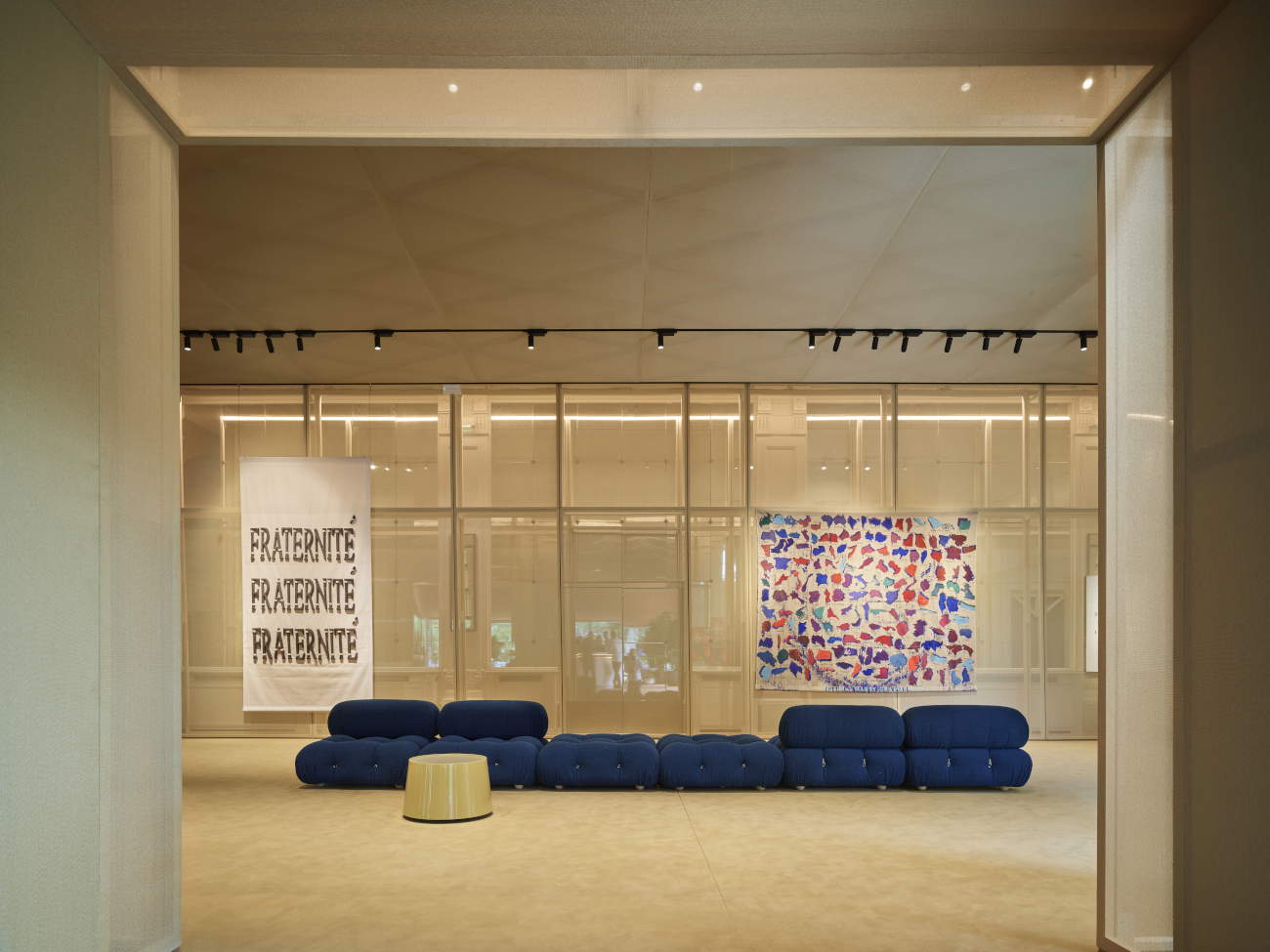
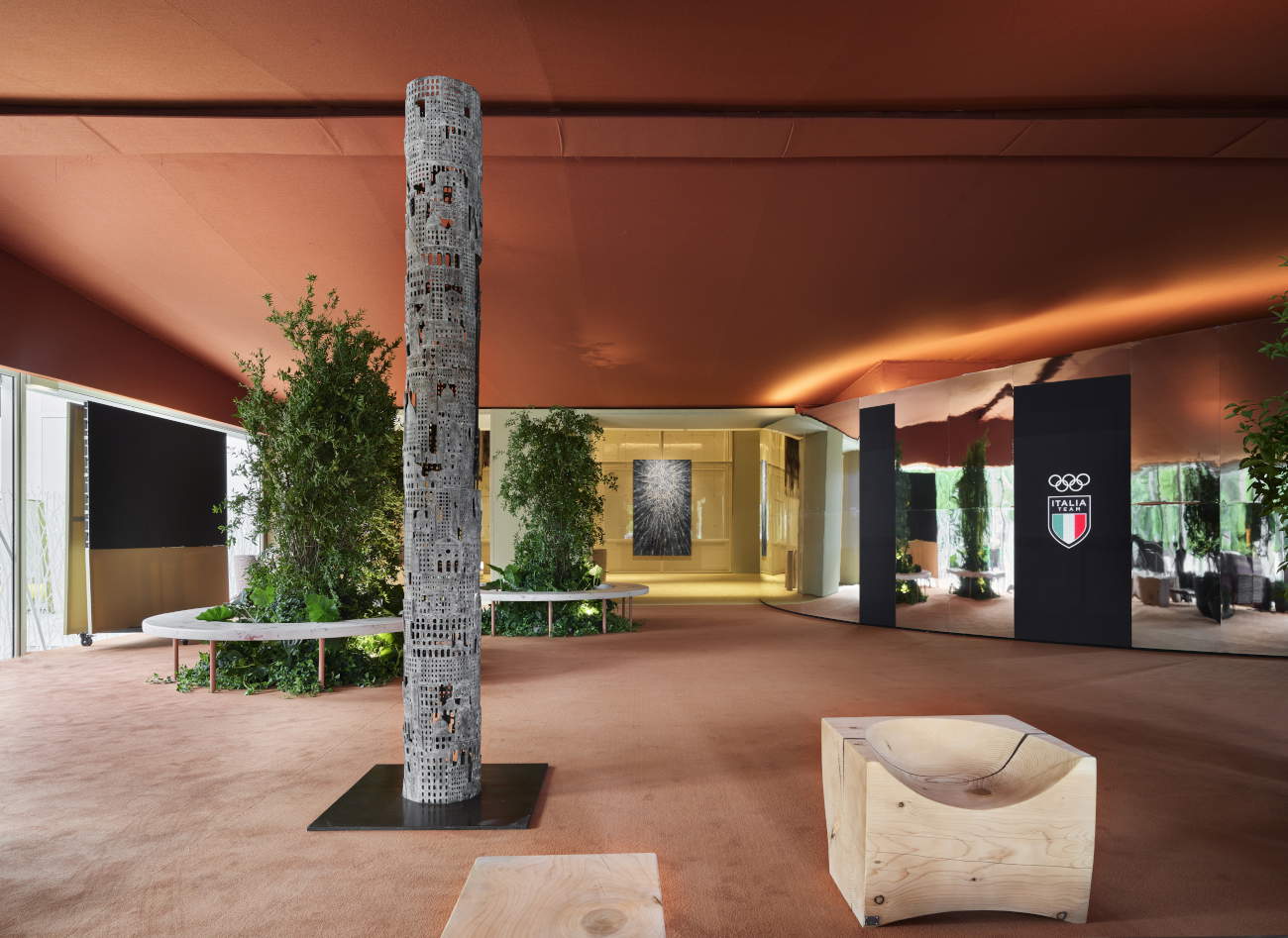
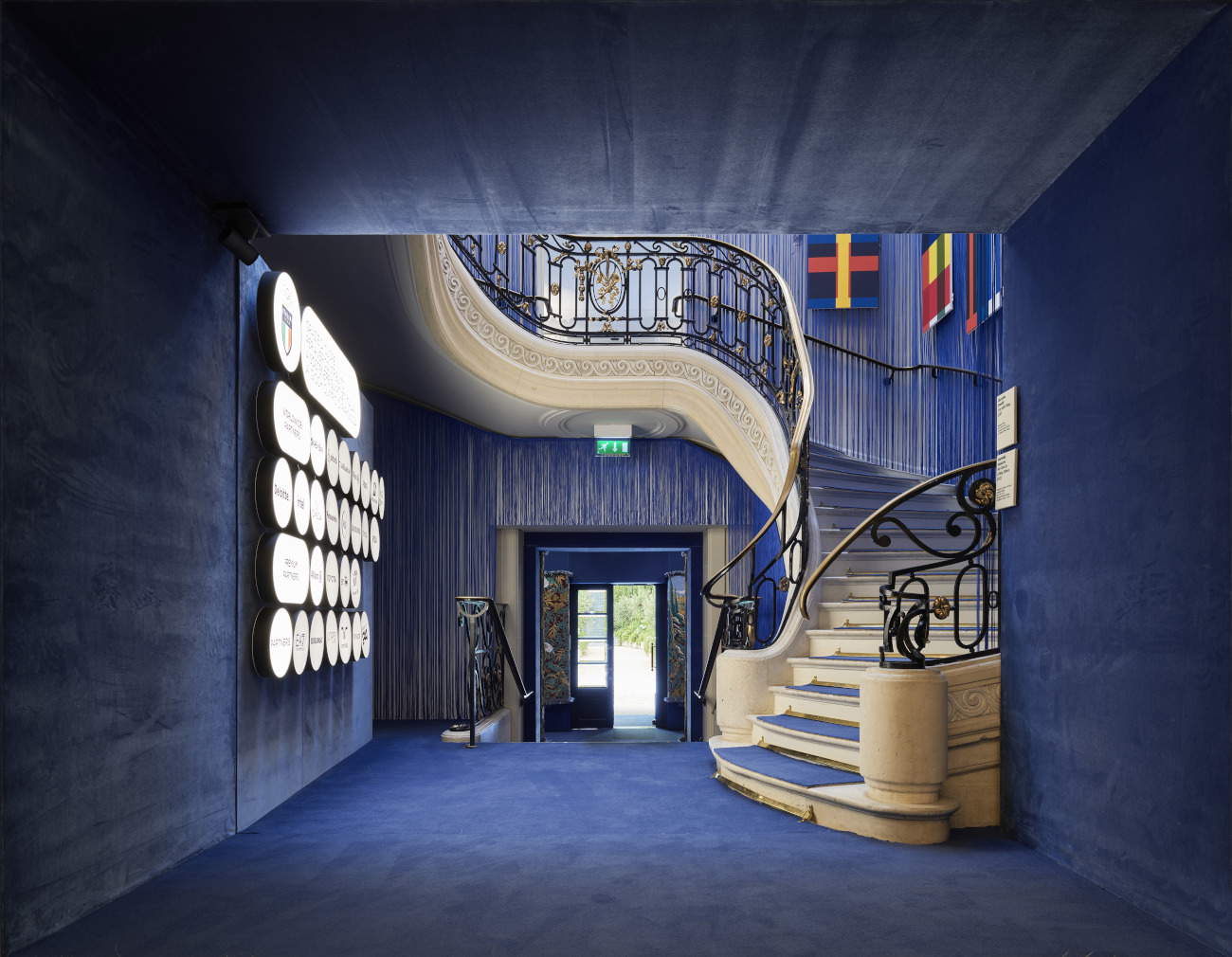
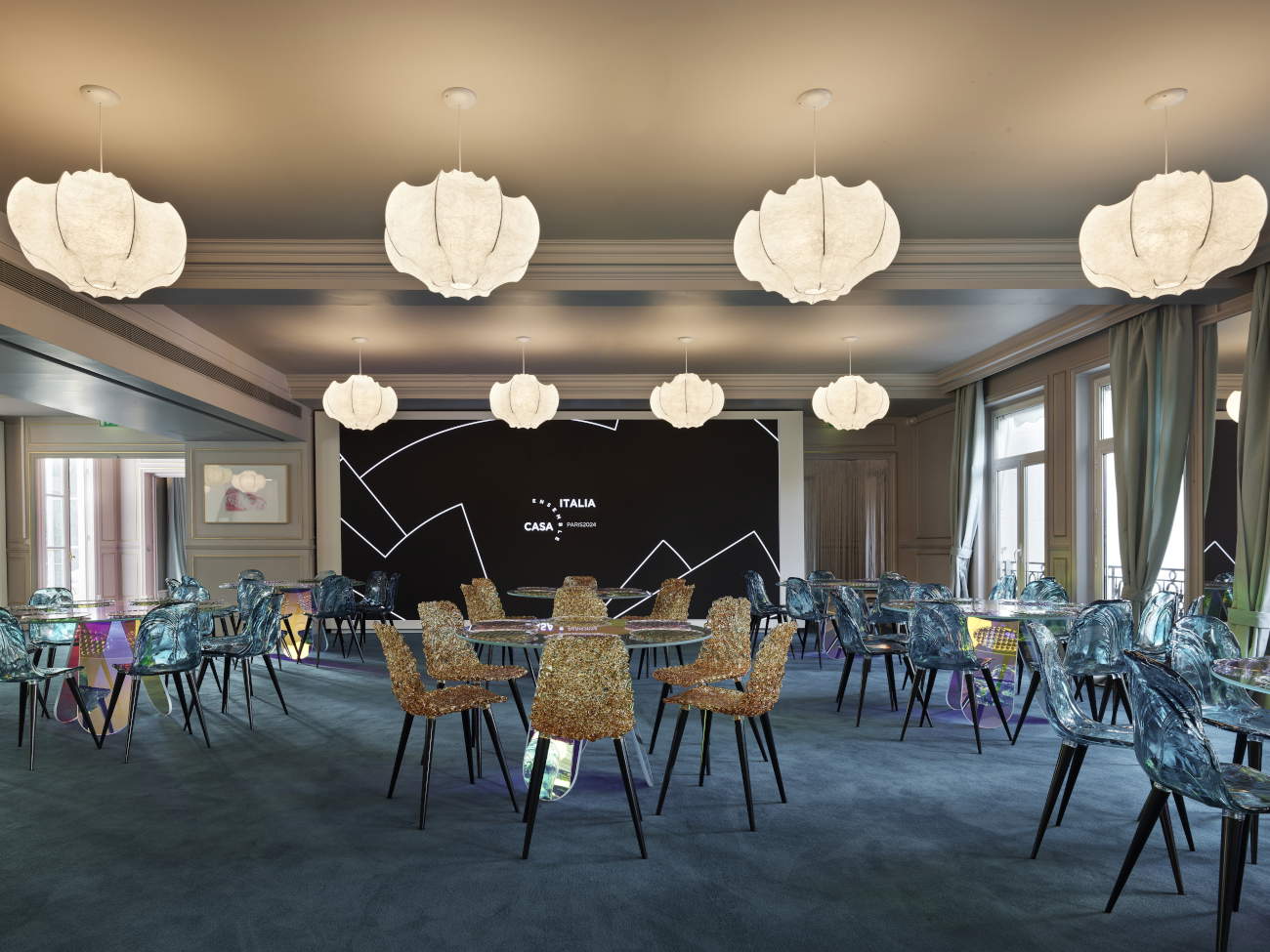
 |
| Paris 2024 Olympics: for the first time, Casa Italia opens to the public with an exhibition and scenic route |
Warning: the translation into English of the original Italian article was created using automatic tools. We undertake to review all articles, but we do not guarantee the total absence of inaccuracies in the translation due to the program. You can find the original by clicking on the ITA button. If you find any mistake,please contact us.



























